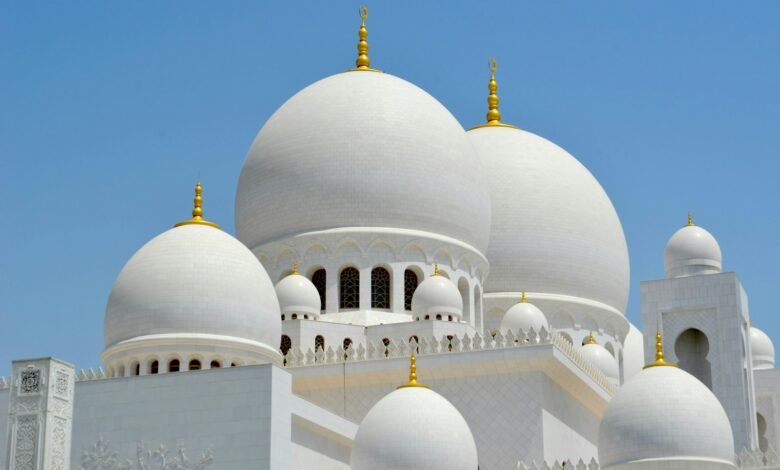
Azerbaijan, located at the crossroads of Europe and Asia, is a country rich in history, culture, and religious diversity. As a predominantly Muslim country, Azerbaijan is home to numerous mosques, ranging from ancient architectural marvels to modern places of worship. Whether you are a Muslim traveler looking for a place to pray or simply interested in exploring the Islamic heritage of Azerbaijan, this guide will help you discover some of the most notable mosques in the country.
1. Bibi-Heybat Mosque (Baku)
The Bibi-Heybat Mosque is one of the most important religious sites in Azerbaijan, located just outside the capital, Baku. Originally built in the 13th century during the Shirvanshah dynasty, the mosque was destroyed by the Soviet regime in 1936. It was later reconstructed in 1997 and now stands as a beautiful combination of Islamic architecture and modern design.
- Architectural Style: Traditional Islamic architecture with modern influences.
- Significance: The mosque is a major pilgrimage site as it houses the tomb of Ukeyma Khanum, a descendant of Prophet Muhammad.
- Facilities: Spacious prayer halls for both men and women.
2. Juma Mosque (Shamakhi)
Located in the town of Shamakhi, the Juma Mosque (Friday Mosque) is one of the oldest mosques in Azerbaijan. Built in 743 AD, it is also one of the oldest mosques in the Caucasus region. The mosque has been damaged and rebuilt several times due to earthquakes, with the latest restoration completed in 2013.
- Architectural Style: Classical Islamic architecture with domes and minarets.
- Significance: It is one of the earliest examples of mosque architecture in the Caucasus.
- Visitor Experience: The mosque is a popular stop for tourists interested in Azerbaijan’s rich Islamic history.
3. Taza Pir Mosque (Baku)
The Taza Pir Mosque, also known as the New Pir Mosque, is another iconic religious site in Baku. The mosque was completed in 1914, and it stands out for its grandeur and intricate design, featuring a large dome, two minarets, and a beautifully decorated interior.
- Architectural Style: Ottoman-inspired design with Azerbaijani influences.
- Significance: Taza Pir is an important religious and cultural landmark in the capital city.
- Facilities: The mosque offers ample space for prayer and religious gatherings, and it is also a venue for Islamic cultural events.
4. Heydar Mosque (Baku)
The Heydar Mosque, named after former Azerbaijani President Heydar Aliyev, is the largest mosque in Azerbaijan and a stunning modern architectural masterpiece. Opened in 2014, the mosque can accommodate up to 7,000 worshippers and is a symbol of Azerbaijan’s commitment to its Islamic heritage.
- Architectural Style: Modern Islamic architecture with grand domes and minarets.
- Significance: The mosque is a major religious hub in Azerbaijan and is frequently visited by both locals and tourists.
- Visitor Experience: Visitors can appreciate the mosque’s size and beauty, particularly its impressive night-time illumination.
5. Blue Mosque (Yukhari Govhar Agha Mosque, Shusha)
The Blue Mosque, located in the historic town of Shusha in the Nagorno-Karabakh region, is known for its beautiful blue-tiled minarets. Built in the 19th century, the mosque has been an important religious site for the local Muslim population.
- Architectural Style: Traditional Azerbaijani Islamic architecture with Persian influences.
- Significance: The mosque is an important symbol of Islamic heritage in Nagorno-Karabakh.
- Current Status: The mosque is undergoing restoration and is a cultural and historical site for both local residents and tourists.
6. Aghdam Juma Mosque (Aghdam)
The Aghdam Juma Mosque, located in the city of Aghdam, is one of the few surviving mosques in the area after the Nagorno-Karabakh conflict. Built in the 19th century, it is a poignant reminder of the region’s history and cultural significance.
- Architectural Style: Ottoman-style architecture with unique Azerbaijani elements.
- Significance: The mosque serves as a symbol of hope and resilience in a region heavily affected by war.
- Visitor Experience: While the mosque is not currently operational, it remains a significant site for those exploring the country’s recent history.
Mosque Etiquette for Travelers
If you plan to visit mosques in Azerbaijan, here are a few tips to ensure a respectful experience:
- Dress Code: Modest attire is required. Men should avoid wearing shorts, and women are expected to cover their heads and wear long sleeves and skirts/pants.
- Shoes: Remove your shoes before entering the mosque. Most mosques have designated areas to store shoes.
- Respect Prayer Times: Avoid visiting during the main prayer times, particularly on Fridays when mosques can be very busy.
- Photography: Always ask for permission before taking photos, especially inside the mosque.
Conclusion
Azerbaijan is home to a variety of stunning mosques that reflect the country’s rich Islamic heritage. From the ancient Juma Mosque in Shamakhi to the modern architectural wonder of the Heydar Mosque in Baku, these sacred places offer not only a space for worship but also a glimpse into the spiritual and cultural history of Azerbaijan. Whether you are a Muslim traveler or someone interested in exploring Islamic architecture, the mosques of Azerbaijan are a must-see.



